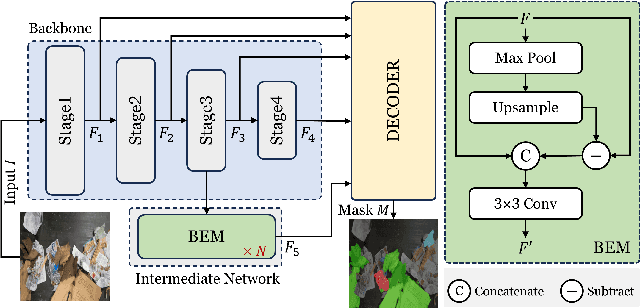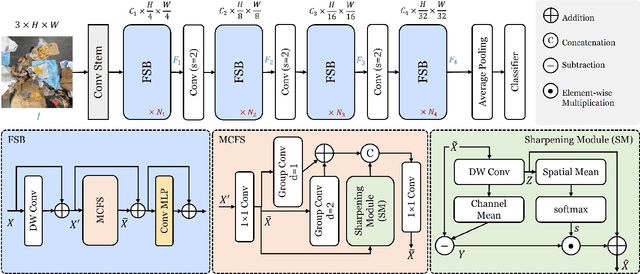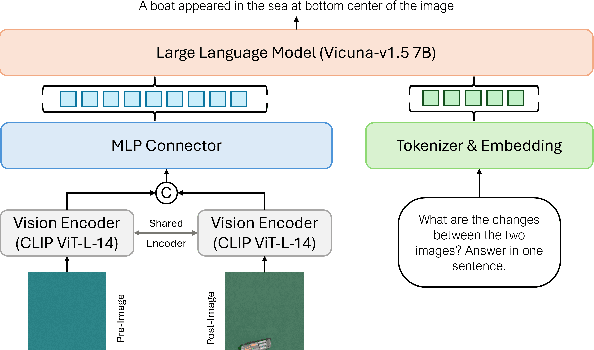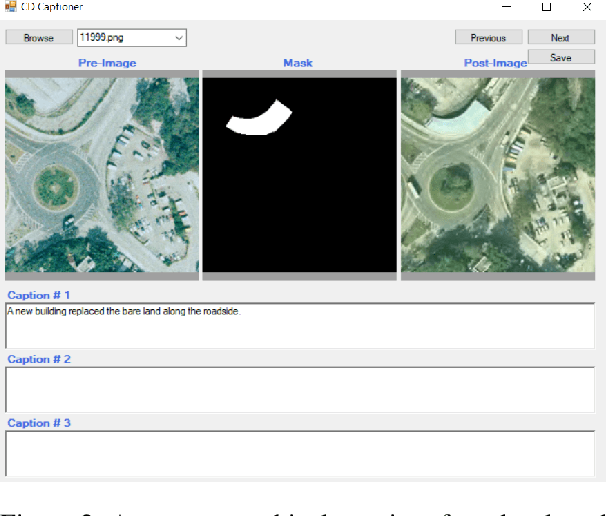Mubashir Noman
HyRet-Change: A hybrid retentive network for remote sensing change detection
Jun 15, 2025Abstract:Recently convolution and transformer-based change detection (CD) methods provide promising performance. However, it remains unclear how the local and global dependencies interact to effectively alleviate the pseudo changes. Moreover, directly utilizing standard self-attention presents intrinsic limitations including governing global feature representations limit to capture subtle changes, quadratic complexity, and restricted training parallelism. To address these limitations, we propose a Siamese-based framework, called HyRet-Change, which can seamlessly integrate the merits of convolution and retention mechanisms at multi-scale features to preserve critical information and enhance adaptability in complex scenes. Specifically, we introduce a novel feature difference module to exploit both convolutions and multi-head retention mechanisms in a parallel manner to capture complementary information. Furthermore, we propose an adaptive local-global interactive context awareness mechanism that enables mutual learning and enhances discrimination capability through information exchange. We perform experiments on three challenging CD datasets and achieve state-of-the-art performance compared to existing methods. Our source code is publicly available at https://github.com/mustansarfiaz/HyRect-Change.
* Accepted at IEEE IGARSS 2025
InceptionMamba: Efficient Multi-Stage Feature Enhancement with Selective State Space Model for Microscopic Medical Image Segmentation
Jun 13, 2025Abstract:Accurate microscopic medical image segmentation plays a crucial role in diagnosing various cancerous cells and identifying tumors. Driven by advancements in deep learning, convolutional neural networks (CNNs) and transformer-based models have been extensively studied to enhance receptive fields and improve medical image segmentation task. However, they often struggle to capture complex cellular and tissue structures in challenging scenarios such as background clutter and object overlap. Moreover, their reliance on the availability of large datasets for improved performance, along with the high computational cost, limit their practicality. To address these issues, we propose an efficient framework for the segmentation task, named InceptionMamba, which encodes multi-stage rich features and offers both performance and computational efficiency. Specifically, we exploit semantic cues to capture both low-frequency and high-frequency regions to enrich the multi-stage features to handle the blurred region boundaries (e.g., cell boundaries). These enriched features are input to a hybrid model that combines an Inception depth-wise convolution with a Mamba block, to maintain high efficiency and capture inherent variations in the scales and shapes of the regions of interest. These enriched features along with low-resolution features are fused to get the final segmentation mask. Our model achieves state-of-the-art performance on two challenging microscopic segmentation datasets (SegPC21 and GlaS) and two skin lesion segmentation datasets (ISIC2017 and ISIC2018), while reducing computational cost by about 5 times compared to the previous best performing method.
PAEFF: Precise Alignment and Enhanced Gated Feature Fusion for Face-Voice Association
May 22, 2025Abstract:We study the task of learning association between faces and voices, which is gaining interest in the multimodal community lately. These methods suffer from the deliberate crafting of negative mining procedures as well as the reliance on the distant margin parameter. These issues are addressed by learning a joint embedding space in which orthogonality constraints are applied to the fused embeddings of faces and voices. However, embedding spaces of faces and voices possess different characteristics and require spaces to be aligned before fusing them. To this end, we propose a method that accurately aligns the embedding spaces and fuses them with an enhanced gated fusion thereby improving the performance of face-voice association. Extensive experiments on the VoxCeleb dataset reveals the merits of the proposed approach.
An Effective Training Framework for Light-Weight Automatic Speech Recognition Models
May 22, 2025Abstract:Recent advancement in deep learning encouraged developing large automatic speech recognition (ASR) models that achieve promising results while ignoring computational and memory constraints. However, deploying such models on low resource devices is impractical despite of their favorable performance. Existing approaches (pruning, distillation, layer skip etc.) transform the large models into smaller ones at the cost of significant performance degradation or require prolonged training of smaller models for better performance. To address these issues, we introduce an efficacious two-step representation learning based approach capable of producing several small sized models from a single large model ensuring considerably better performance in limited number of epochs. Comprehensive experimentation on ASR benchmarks reveals the efficacy of our approach, achieving three-fold training speed-up and up to 12.54% word error rate improvement.
COSNet: A Novel Semantic Segmentation Network using Enhanced Boundaries in Cluttered Scenes
Oct 31, 2024



Abstract:Automated waste recycling aims to efficiently separate the recyclable objects from the waste by employing vision-based systems. However, the presence of varying shaped objects having different material types makes it a challenging problem, especially in cluttered environments. Existing segmentation methods perform reasonably on many semantic segmentation datasets by employing multi-contextual representations, however, their performance is degraded when utilized for waste object segmentation in cluttered scenarios. In addition, plastic objects further increase the complexity of the problem due to their translucent nature. To address these limitations, we introduce an efficacious segmentation network, named COSNet, that uses boundary cues along with multi-contextual information to accurately segment the objects in cluttered scenes. COSNet introduces novel components including feature sharpening block (FSB) and boundary enhancement module (BEM) for enhancing the features and highlighting the boundary information of irregular waste objects in cluttered environment. Extensive experiments on three challenging datasets including ZeroWaste-f, SpectralWaste, and ADE20K demonstrate the effectiveness of the proposed method. Our COSNet achieves a significant gain of 1.8% on ZeroWaste-f and 2.1% on SpectralWaste datasets respectively in terms of mIoU metric.
CDChat: A Large Multimodal Model for Remote Sensing Change Description
Sep 24, 2024



Abstract:Large multimodal models (LMMs) have shown encouraging performance in the natural image domain using visual instruction tuning. However, these LMMs struggle to describe the content of remote sensing images for tasks such as image or region grounding, classification, etc. Recently, GeoChat make an effort to describe the contents of the RS images. Although, GeoChat achieves promising performance for various RS tasks, it struggles to describe the changes between bi-temporal RS images which is a key RS task. This necessitates the development of an LMM that can describe the changes between the bi-temporal RS images. However, there is insufficiency of datasets that can be utilized to tune LMMs. In order to achieve this, we introduce a change description instruction dataset that can be utilized to finetune an LMM and provide better change descriptions for RS images. Furthermore, we show that the LLaVA-1.5 model, with slight modifications, can be finetuned on the change description instruction dataset and achieve favorably better performance.
FANet: Feature Amplification Network for Semantic Segmentation in Cluttered Background
Jul 12, 2024Abstract:Existing deep learning approaches leave out the semantic cues that are crucial in semantic segmentation present in complex scenarios including cluttered backgrounds and translucent objects, etc. To handle these challenges, we propose a feature amplification network (FANet) as a backbone network that incorporates semantic information using a novel feature enhancement module at multi-stages. To achieve this, we propose an adaptive feature enhancement (AFE) block that benefits from both a spatial context module (SCM) and a feature refinement module (FRM) in a parallel fashion. SCM aims to exploit larger kernel leverages for the increased receptive field to handle scale variations in the scene. Whereas our novel FRM is responsible for generating semantic cues that can capture both low-frequency and high-frequency regions for better segmentation tasks. We perform experiments over challenging real-world ZeroWaste-f dataset which contains background-cluttered and translucent objects. Our experimental results demonstrate the state-of-the-art performance compared to existing methods.
ChangeBind: A Hybrid Change Encoder for Remote Sensing Change Detection
Apr 26, 2024Abstract:Change detection (CD) is a fundamental task in remote sensing (RS) which aims to detect the semantic changes between the same geographical regions at different time stamps. Existing convolutional neural networks (CNNs) based approaches often struggle to capture long-range dependencies. Whereas recent transformer-based methods are prone to the dominant global representation and may limit their capabilities to capture the subtle change regions due to the complexity of the objects in the scene. To address these limitations, we propose an effective Siamese-based framework to encode the semantic changes occurring in the bi-temporal RS images. The main focus of our design is to introduce a change encoder that leverages local and global feature representations to capture both subtle and large change feature information from multi-scale features to precisely estimate the change regions. Our experimental study on two challenging CD datasets reveals the merits of our approach and obtains state-of-the-art performance.
ELGC-Net: Efficient Local-Global Context Aggregation for Remote Sensing Change Detection
Mar 26, 2024Abstract:Deep learning has shown remarkable success in remote sensing change detection (CD), aiming to identify semantic change regions between co-registered satellite image pairs acquired at distinct time stamps. However, existing convolutional neural network and transformer-based frameworks often struggle to accurately segment semantic change regions. Moreover, transformers-based methods with standard self-attention suffer from quadratic computational complexity with respect to the image resolution, making them less practical for CD tasks with limited training data. To address these issues, we propose an efficient change detection framework, ELGC-Net, which leverages rich contextual information to precisely estimate change regions while reducing the model size. Our ELGC-Net comprises a Siamese encoder, fusion modules, and a decoder. The focus of our design is the introduction of an Efficient Local-Global Context Aggregator module within the encoder, capturing enhanced global context and local spatial information through a novel pooled-transpose (PT) attention and depthwise convolution, respectively. The PT attention employs pooling operations for robust feature extraction and minimizes computational cost with transposed attention. Extensive experiments on three challenging CD datasets demonstrate that ELGC-Net outperforms existing methods. Compared to the recent transformer-based CD approach (ChangeFormer), ELGC-Net achieves a 1.4% gain in intersection over union metric on the LEVIR-CD dataset, while significantly reducing trainable parameters. Our proposed ELGC-Net sets a new state-of-the-art performance in remote sensing change detection benchmarks. Finally, we also introduce ELGC-Net-LW, a lighter variant with significantly reduced computational complexity, suitable for resource-constrained settings, while achieving comparable performance. Project url https://github.com/techmn/elgcnet.
Rethinking Transformers Pre-training for Multi-Spectral Satellite Imagery
Mar 08, 2024Abstract:Recent advances in unsupervised learning have demonstrated the ability of large vision models to achieve promising results on downstream tasks by pre-training on large amount of unlabelled data. Such pre-training techniques have also been explored recently in the remote sensing domain due to the availability of large amount of unlabelled data. Different from standard natural image datasets, remote sensing data is acquired from various sensor technologies and exhibit diverse range of scale variations as well as modalities. Existing satellite image pre-training methods either ignore the scale information present in the remote sensing imagery or restrict themselves to use only a single type of data modality. In this paper, we re-visit transformers pre-training and leverage multi-scale information that is effectively utilized with multiple modalities. Our proposed approach, named SatMAE++, performs multi-scale pre-training and utilizes convolution based upsampling blocks to reconstruct the image at higher scales making it extensible to include more scales. Compared to existing works, the proposed SatMAE++ with multi-scale pre-training is equally effective for both optical as well as multi-spectral imagery. Extensive experiments on six datasets reveal the merits of proposed contributions, leading to state-of-the-art performance on all datasets. SatMAE++ achieves mean average precision (mAP) gain of 2.5\% for multi-label classification task on BigEarthNet dataset. Our code and pre-trained models are available at \url{https://github.com/techmn/satmae_pp}.
 Add to Chrome
Add to Chrome Add to Firefox
Add to Firefox Add to Edge
Add to Edge